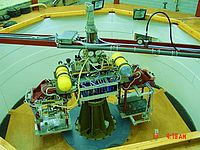Geotechnical Centrifuges
General Information
Instruments:
2 geo-centrifuges.
Description:
Centrifuge modelling of geotechnical problems provide an understanding of the mechanisms involved in each particular process and has the potential to create well documented, highly-instrumented case studies of soil behaviour, in which the material properties, initial state, and boundary conditions are all well-defined. In the centrifuge tests a model with geometry of N times smaller than the prototype is constructed and is tested under centrifugal acceleration field with a magnitude of N times the Earth’s gravity (Schofield, 1980). This situation provides a gradient of body stresses within the model similar to the prototype, which ensures similar effective stresses and groundwater pressures at equivalent depths. However, it is essential to consider the appropriate scaling laws, the potential conflicts between them (e.g. Askarinejad et al., 2014), and the boundary conditions to replicate accurately the physical phenomena being studied (Davies et al., 2010).
Location:
Laboratory of Geoscience and Engineering, Faculty of Civil Engineering and Geosciences, Stevinweg 1, Delft (Building #23).
Key Words:
Geo-Centrifuge, Physical Modelling in Geotechnics, Small Scale Testing.
Main Application:
Offshore geotechnical engineering: Spud-cans, suction caissons (bucket foundations), landslides
Dikes and embankments
Soil structure interaction: piles, shallow foundations
Tunnelling
Slope stability (landslides)
Unsaturated soil mechanics
Soil vegetation interaction
Dynamic effects on geotechnical structures
Surface subsidence
Instrument Specification:
1. Main centrifuge:
Maximum payload: 30 Kgf
Max. Acceleration: 300 g
Nominal radius: 1.3 m
Basket size: 400x400x500mm
Max. rotation velocity: 450 RPM
Facilities
Inflight sand pluviator
Two dimensional loading frame
Inflight Shear Vane apparatus
Pile driving hammer
Suction caisson installer
Earthquake actuator
Cameras: Particle Image Velocimetry (PIV)
2. Small centrifuge (mainly for consolidation of specimens):
Max. Acceleration: 100 g
Nominal radius: 0.5 m
References:
Askarinejad, A., Beck, A., and Springman, S.M. (2014). Scaling law of static liquefaction mechanism in geo-centrifuge and corresponding hydro-mechanical characterization of an unsaturated silty sand having a viscous pore fluid. Canadian Geotechnical Journal, In print. DOI: 10.1139/cgj-2014-0237.
Allersma, H.G.B., 1994. The University of Delft geotechnical centrifuge. Int. Conf. Centrifuge 94,Singapore, 31 August-2 Sept. pp.47-52.
Allersma, H.G.B., 1994. Development of miniature equipment for a small geotechnical centrifuge. Transportation Research Record No.1432, National Academic Press Washinghton, D.C. pp. 99-105.
Allersma, H.G.B., B. Hospers and M.G. den Braber, 1996. Centrifuge tests on the sliding behaviour of spudcans. 49th Canadian Geotechnical Conference. St John's September 23-25, 1996, pp. 199-206.
Allersma, H.G.B., 1997. Centrifuge tests on widening of embankments on soft soil. Third Geotechnical Engineering Conference, Egypt, Cairo University, Jan. 5-8,1997, pp. 43-54.
Allersma, H.G.B., 1999. Application of small beam centrifuge in geotechnical research. 3th Int. Conf. on Seismology and Earthquake Eng.,IIEES, Tehran, pp.445-454.
Davies, M., Bowman, E. & White, D. (2010). Physical modelling of natural hazardsPhysical Modelling in Geotechnics, Two Volume Set: Proceedings of the 7th International Conference on Physical Modelling in Geotechnics (ICPMG 2010), 28th June-1st July, Zurich, Switzerland, CRC Press, 3.
Schofield, A.N. (1980). Cambridge Geotechnical Centrifuge Operations. Géotechnique, 30(3): 227-268.

Dr. Miguel Angel Cabrera
- + 31 15 27 83663
- M.A.Cabrera@tudelft.nl
-
Room 00.500
Personal Page
Staff Page